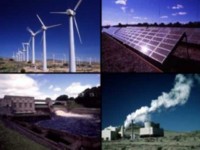Top Ten Growth Markets in Air, Water and Energy
 For suppliers of products and services for the air, water, and energy industries, the McIlvaine Company has identified some substantial double-digit growth opportunities. Ten of these that have been identified as the most promising are ranked here based on potential market size.
For suppliers of products and services for the air, water, and energy industries, the McIlvaine Company has identified some substantial double-digit growth opportunities. Ten of these that have been identified as the most promising are ranked here based on potential market size.#1 Shale Gas - There is a very large continuing investment in extraction of gas from shale in the U.S. The requirement for hydraulic fracturing two miles underground greatly increases the investment in flow control and treatment products. The U.S. now has access to reserves which could make it a net exporter or at least self sufficient for thirty years. The big unknown is the potential in China and the rest of the world.
China has bigger reserves but they are deeper. There is also a lack of water in the areas where it will be required. Nevertheless, China plans 60 billion m3 of capacity by 2020.
#2 Vessel Air and Water Treatment - $70 billion will be required to supply 70,000 ships with treatment systems to ensure that ballast water discharges be free of live invasive species. Large investments will also be needed to reduce sulfur and NOx emissions from the ship stacks.
#3 Water Reuse - Power plants and other large water users will accelerate the treatment and use of wastewater. The co-location of municipal wastewater treatment plants and either combined cycle gas turbine or coal-fired power plants will be a popular option. Industrial facilities will increasingly opt to treat and reuse wastewater rather than discharge it. The investment in treatment systems and chemicals for this purpose will be substantial.
#4 NOx Control - Coal-fired power plant operators in China are embarked on a huge program to install DeNOx systems using selective catalytic reduction. In Europe and the U.S., regulations requiring NOx reduction on trucks and other vehicles will ensure double-digit growth in this segment. Suppliers of urea and ammonia will benefit from both the stationary and mobile activity.
#5 Aquaculture - The new generation involving recirculating tanks and efficient filtration is changing the approach to fish farming. The continuing depletion of wild fish populations is also a driving factor.
#6 Efficiency Improvements in Fossil Plants - The average age of coal-fired power plants in the U.S. is forty years. The efforts to prevent new power plant construction in the U.S. and Europe are forcing operators of existing power plants to modernize. One of the biggest needs is to replace outdated instrumentation and controls and to make the power plants much more efficient.
#7 Remediation - The remediation of soil and groundwater is becoming a big business in developing countries. It will generate $36 billion in revenue this year.
#8 Fine Particulate Reductions - Small particles are increasingly identified as the most harmful contaminants in air. The resultant legislation will continue to bolster both the mobile and stack gas markets for reduction technology. Fabric filters will replace electrostatic precipitators in many cement and power plants.
#9 Management of Solid Waste - Waste-to-energy through combustion of solid wastes or generation of biogas will replace landfill as a disposal method in developing countries. The U.S. is one of the few developed countries which tolerate landfills as a solution.
#10 Renewables - The short-term outlook for wind and solar has been negatively impacted by the shale gas discoveries and production. Cut throat pricing and oversupply have battered the solar cell manufacturers. Nevertheless, the “renewables” market will weather the storm and again become healthy.
You can return to the main Market News page, or press the Back button on your browser.

